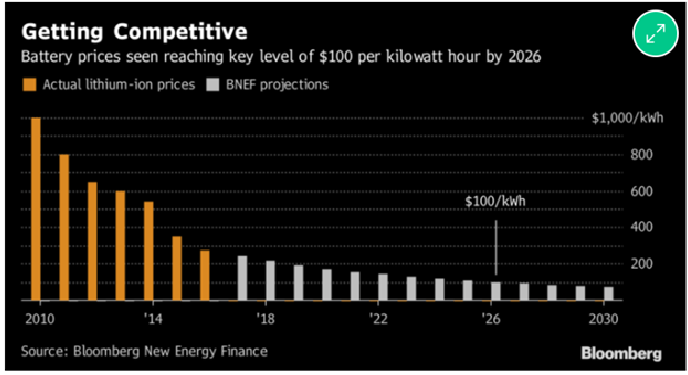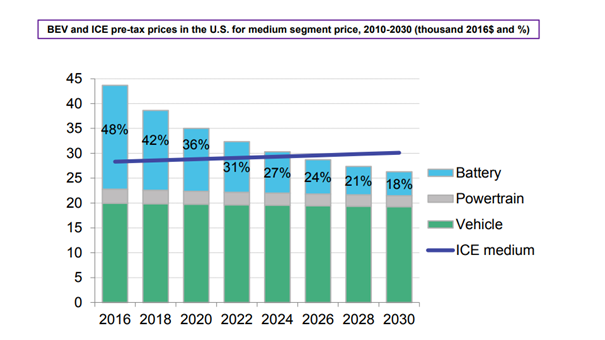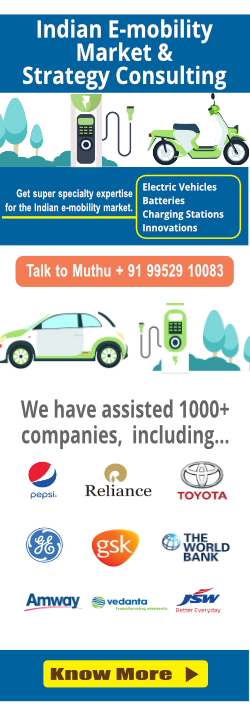Last updated: Feb 2020 by Narasimhan Santhanam
This pos![]() t is a part of EV Next’s EV Perspectives.
t is a part of EV Next’s EV Perspectives.
EV Next, a division of EAI, is a leading market intelligence & strategic consulting firm for the Indian e-mobility sector.
Get to know about 1000+ EV innovations from EVI2: Electric Vehicle Innovation Intelligence from EVNext
Introduction
The two major technologies of batteries used in electric vehicles are Li-ion and Lead Acid. Out of that, Li-ion batteries are more expensive to manufacture. In fact, the total product cost of this battery is around 40 percent higher than the nickel-metal hydride battery. The battery needs an onboard computer circuitry to manage and ensure that voltage and current are well within the safe limits. This circuitry makes it more expensive.
- Lead-acid batteries are more economical batteries available on the market, both on their initial cost as well as cost per kWh.
- As Li-ion batteries are becoming more prevalent for a range of electric vehicles and as it is the more expensive of the alternatives, it is instructive to see how the Li-ion battery costs are likely to trend in future.
The chart above shows how the Li-ion battery costs & prices have trended. Starting with a cost of about $1000/kWh in 2010, the costs have dropped to just over $200/kWh in 2018 – an exceptional drop of 80% in just 8 years.
How did such a dramatic drop happen? Was there any major breakthrough in technology? Nopes. The main reason for the cost decrease simply has been the economies of scale. From practically no electric vehicles on the road (except for the occasional Toyota Prius, even which was a hybrid electric vehicle), in 2018 alone, 2 million electric cars were sold worldwide (Top 3 sales were by Tesla Model 3, BAIC EC Series & Nissan Leaf). In 2017, sales were 1 million. That is, there was a 100% increase in electric car sales 2017 to 2018. By end of 2018, the world had a cumulative 5 million electric cars on road – still a very small percentage compared to the total of about 1 billion cars (1000 million cars) on road, but much higher than what they were earlier.
So, Li-ion battery prices came crashing down owing to the much larger volumes of batteries produced. If this were the case, what does it portend for the future, when electric vehicle sales are expected to be at much higher levels?
Let’s look at what the electric car numbers for the future look like. An EU report predicts that there will be at least 50 million electric cars on roads by 2028, and this could rise to an astonishing 900 million electric cars on the road by 2040, by when a total of about 2 billion cars are expected on the roads – so electric cars could be about 50% of total cars on roads by 2040, from an insignificantly small percentage (0.5%, if you wish to know the exact number!) by end of 2018.
So, how would this growth in electric vehicles translate to cost decreases for the Li-ion battery?
Moving forward, the cost is expected to drop to sub-$200 in 2019 and continue decreasing. The magic number of $100/kWh is expected to be reached around 2025-2026.
Why is the $100/kWh a significant milestone? The chart below tells why.
The chart above shows the prices of Electric Vehicles and the comparative prices of ICE vehicles. As one can see, in 2018, the costs of EVs are on average about 25-30% higher than ICE vehicles. This gap continues closing owing mainly due to the decreasing costs of batteries and by 2026, when the battery costs touch about $100/kWh, the cost parity between battery vehicles and ICE vehicles is achieved. Beyond this year, electric vehicles are likely to cost less than ICE vehicles!
But the above is just one estimate. An EU report is a bit less optimistic, and predicts a 50% drop in battery prices by 2030 – so, if we were to go with this estimate, we should expect a sub-$100/kWh closer to 2030.
Cost parity is a critical aspect for any commercialization efforts, as it signals the taking over of market forces in the growth of a product. With lower costs than ICE vehicles and better performance, one can thus expect the electric vehicles sales to grow much faster starting 2025/2026.
Battery chemistry: as explained in later sections, new battery chemistries are rolled out on a continuous basis. This trend is expected to continue as battery OEMs are trying to achieve better performance and lower battery costs. Since most Li-ion batteries use significant amounts of expensive metals (particularly Cobalt), future vehicles will be equipped with batteries containing lower amounts of Cobalt and higher quantities of cheaper substitute metals (Nickel and Manganese).
- For example, the dominant battery technology in vehicles manufactured in 2020 is NMC 622 (containing a ratio of Ni:Co:Mn of 6:2:2), whilst 2025’s vehicle will utilise a higher proportion (35%) of NMC 811 batteries (8 Ni: 1 Co: 1 Mn), as depicted in the diagram below. As the development of low cobalt batteries progresses, NMC 9.5.5 batteries (containing 9 parts Ni, 0.5 part Co, and 0.5 parts Mn) will cannibalise older and more expensive technologies by 2030.
Demand for EV batteries by chemistry in Europe
The technology has matured and prismatic and pouch cells have the potential for greater capacity than the cylindrical format. Large flat packs serve electric powertrains and Energy Storage System (ESS) with good results. The cost per kWh in the prismatic/pouch cell is still higher than with the 18650 cell but this is changing. Figure below compares the price of the cylindrical, prismatic and pouch cells, also known as laminated.
- Flat-cell designs are getting price competitive and battery experts predict a shift towards these cell formats, especially if the same performance criteria of the cylindrical cell can be met.
- Manufacturing costs of prismatic and pouch formats (laminate) were higher, but they are converging with cellular design. Pricing involves the manufacturing of the bare cells only.
- Asian cell manufacturers anticipate cost reductions of the four most common Li-ion cells, which are the 18650, 21700, prismatic and pouch cells. The 21700 promises the largest cost decrease over the years and economical production, reaching price equilibrium with the pouch by 2025(Fig below)
Summary
With the pouch cell, the manufacturer is attempting to simplify cell manufacturing by replicating the packaging of food. Each format has pros and cons as summarized below.
- Cylindrical cells have high specific energy, good mechanical stability and lends itself to automated manufacturing. Cell design allows added safety features that are not possible with other formats (see BU-304b: Making Lithium-ion Safe); it cycles well, offers a long calendar life and is low cost, but it has less than ideal packaging density. The cylindrical cell is commonly used for portable applications.
- Prismatic cells are encased in aluminum or steel for stability. Jelly-rolled or stacked, the cell is space-efficient but can be costlier to manufacture than the cylindrical cell. Modern prismatic cells are used in the electric power train and energy storage systems.
- Pouch cell uses laminated architecture in a bag. It is light and cost-effective but exposure to humidity and high temperature can shorten life. Adding a light stack pressure prolongs longevity by preventing delamination. Swelling of 8–10 percent over 500 cycles must be considered with some cell designs. Large cells work best with light loading and moderate charge times. The pouch cell is growing in popularity and serves similar applications to the prismatic cell.
==
Post this blog’s original publishing date, there have been a number of updates on the battery cost trends. Here are links to some of them:
- A behind-the-scenes take on Li-ion battery prices – from Bloomberg New Energy Finance (BNEF) – a detailed analytical report, Mar 2019 – Link to report
- Battery reality – There’s nothing better than Li-ion coming soon – Apr 2019 – Link to report
- How we get to the next battery breakthrough – Quartz – Link to report
- Risk of slower-than-expected declines for Li batteries – Navigant Research – Link to report
Read more on the economics of e-mobility from: Prices of Indian EVs | Indian EV Challenges | EV Battery Swapping | EVSE Cost Components | EVSE Installation Costs | Li-ion Batteries Costs |
![]() Know more on how EV Next can assist your business in your strategy for the e-mobility and electric vehicles sectors, Here
Know more on how EV Next can assist your business in your strategy for the e-mobility and electric vehicles sectors, Here
Wish to know everything about India’s EV market from one place? Check out the India EV Expert Guide, an 800 page comprehensive guide to the Indian EV market. Here
Get to know about 1000+ EV innovations from EVI2: Electric Vehicle Innovation Intelligence from EVNext
See also the related blog posts
- World’s Leading Suppliers of Li-ion Batteries for EVs – Global Electric Vehicle Battery Vendors
- India Electric Vehicle Market Strategic Insights & Perspectives from EAI
Comprehensive Inputs on Indian EV Ecosystem
Check out the following sections for comprehensive inputs on Indian EV ecosystem (click on each section for more details)



















I want to put up a manufacturing plant for lithium ion batteries for EV. Can u assist me with all the required details. Thank you.